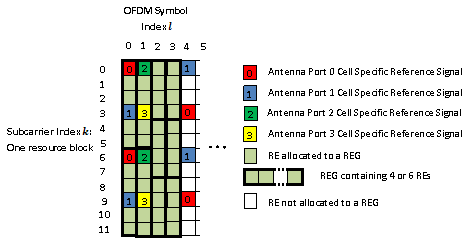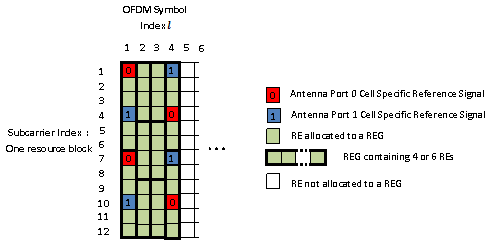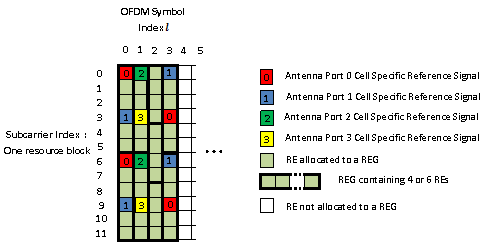Resource Element Groups (REGs)
You can use resource element groups (REGs) to define the mapping of control channels to resource elements (RE).
REGs are blocks of consecutive REs within the same OFDM symbol. The REGs within a subframe are located in the first four OFDM symbols and are identical in size and number for each corresponding subframe on every antenna port.
Resource Element Group Indexing
A pair of indices represents a REG. The index is the subcarrier index of the RE that has the lowest subcarrier index k in the REG. The index is the OFDM symbol index of the REG (l). This figure shows how index pairs represent REGs.

Size and Location of REGs
The number of REs within a REG is such that a REG contains four REs that are not occupied by a cell-specific reference signal on any antenna port in use.
All REs within a resource block in one of the first four OFDM symbols belong to a REG. Therefore the number of REs within each REG and the number of REGs within an OFDM symbol are affected by the number of cell-specific reference signals present on all antenna ports.
The number and location of cell-specific reference signals depend on the number of antenna ports and the type of cyclic prefix.
Antenna Port Configurations
Each antenna port has a unique cell-specific reference signal associated with it. C-specific reference signals affect the REG arrangement. Therefore, the REG arrangement differs between a one or two antenna port configuration and a four antenna port configuration. The REG arrangement for each resource block within a subframe and for every antenna port is identical.
REG Arrangement with a Normal Cyclic Prefix
The REG arrangement for each antenna port configuration is described below for a normal cyclic prefix.
One or Two Antenna Port Configuration
When you use antenna port 0 or antenna ports 0 and 1, the software assumes the cell-specific reference signal is present on both antenna ports 0 and 1. This leads to a REG arrangement for each resource block as shown in this figure.

Cell-specific reference signals are present within the first OFDM symbol. Since four REs not containing cell-specific reference signals are required in a REG, the 12 REs in the first symbol are divided into two REGs, each containing six REs (two containing cell-specific reference signals and four empty). In the second and third OFDM symbols no cell-specific reference signal is present, so the 12 REs in each symbol are divided between three REGs, each containing four REs.
Four Antenna Port Configuration
The REG arrangement in each resource block for a four-antenna port configuration is shown in this figure.

The REG allocation within the first OFDM symbol is the same as for a one- or two- antenna port configuration. Four cell-specific reference signals are present in the second OFDM symbol therefore eight REs are available for the mapping of control data. The 12 REs are divided into two REGs, each containing six REs. The third and fourth OFDM symbols contain no reference signals so three REGs are available.
REG Arrangement with an Extended Cyclic Prefix
An extended cyclic prefix subframe contains 12 OFDM symbols as opposed to 14 for a normal cyclic prefix. Since the number of cell-specific reference signals in a normal or extended cyclic prefix subframe is the same, the limited number of OFDM symbols in an extended cyclic prefix subframe requires the OFDM symbol spacing of the cell-specific reference signals to be reduced compared to a standard cyclic prefix.
This reduction in spacing causes cell-specific reference signals to be present within the fourth OFDM symbol of an extended cyclic prefix subframe. In a normal cyclic prefix subframe no cell-specific reference signals are present. Therefore, when an extended cyclic prefix is used, there are two REGs, each containing six REs, in the fourth OFDM symbol.
The number of cell-specific reference symbols within the first three OFDM symbols is identical for normal or extended cyclic prefix therefore the REG configurations are identical.
One or Two Antenna Port Configuration
The REG arrangement for a one or two antenna port configuration when using an extended cyclic prefix is shown in this figure.

Four Antenna Port Configuration
The REG arrangement for a four antenna port configuration when using an extended cyclic prefix is shown in this figure.

See Also
ltePDCCH | ltePHICH | ltePCFICH